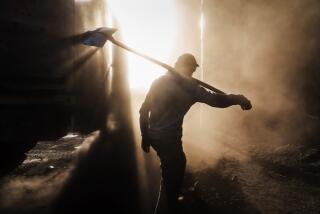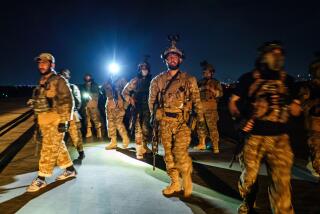GIs Scour Afghan Caves After Fighting
- Share via
KABUL, Afghanistan — Hundreds of U.S. soldiers searched a maze of caves for weapons caches Tuesday after subduing scores of heavily armed Afghan rebels said to be loyal to a renegade warlord in the largest-scale fighting in Afghanistan in 10 months.
At least 18 of about 80 rebels reportedly were killed in the fighting, which began Monday in the mountains of southeastern Afghanistan, near the town of Spin Buldak close to the border with Pakistan.
There were no casualties among the more than 200 U.S. soldiers and allied Afghan militia troops, U.S. military officials said.
The fighting ended with U.S. and coalition forces cordoning off the area and beginning an intensive search for hidden arms and rebel fighters. As of Tuesday night, one small weapons cache had been found, Navy Lt. Dan Hetlage, a Pentagon spokesman, said in Washington.
The rebels appeared to be hard-line Islamic followers of warlord Gulbuddin Hekmatyar, U.S. military officials said. The officials did not elaborate on what evidence pointed to Hekmatyar.
“Our intelligence leads us to believe that they are most closely aligned with the Hezb-i-Islami movement, which is Hekmatyar’s military arm,” U.S. Army spokesman Col. Roger King told reporters at Bagram air base north of Kabul, the capital.
But Gul Haidar, commander of Afghan government troops in the southern zone where the fighting took place, said the guerrillas had nothing to do with Hekmatyar.
Hekmatyar’s alliances have shifted over the years. His force was one of the U.S.-aided guerrilla armies that fought the Soviets in the 1980s.
After the Soviets were defeated in 1989, Hekmatyar served briefly as Afghanistan’s prime minister. Now the former foe of the Taliban has taken up arms with remnants of the radical Islamic regime.
“It is true that Gulbuddin is trying to confuse the situation in some parts of the country,” Afghan Defense Ministry spokesman Abdul Wodud said. “But he won’t be able to do that. We are strongly opposed to it and struggling, with the international community, to annihilate any terrorist movement like this in Afghanistan.”
The rebels may be trying to exploit any weaknesses in U.S. forces as attention is diverted to a possible war with Iraq, a scenario that American and Afghan commanders have warned of repeatedly in recent weeks.
King said the rebels were part of an estimated force of 80 fighters loyal to Hekmatyar and called it the largest group of enemy fighters to take on U.S. forces since Operation Anaconda in March. In that battle, about 1,200 U.S. troops fought 1,000 Taliban fighters in the mountains of eastern Afghanistan.
Eight Americans were among 11 allied soldiers killed in Operation Anaconda, and 70 more were wounded. The U.S. military said it killed 450 to 650 Taliban soldiers in that battle.
The latest fighting, centered 14 miles north of Spin Buldak, was triggered by a small shootout Monday pitting armed attackers against U.S. Special Forces soldiers and their Afghan government allies working to clear a mud-walled compound.
One attacker was killed and one was captured, King said. The detainee told questioners that a large group of armed men had massed in mountains nearby.
Apache helicopters sent to investigate came under small-arms fire, and then fighter aircraft returned to pound the area.
The Americans called in reinforcements on the ground and in the air, and for at least 12 hours Monday night and early Tuesday, allied forces delivered a fierce barrage of airstrikes, including 19 2,000-pound bombs and two 500-pound guided missiles on a series of caves in the remote highlands region.
The air power included U.S. B-1 bombers, AC-130 gunships that carry computer-aimed artillery guns and European F-16 fighter bombers, including at least one from Norway -- that country’s first bombs in battle since World War II.
There have been a series of attacks against U.S. and coalition forces along Afghanistan’s border with Pakistan in recent months, including one in December that left one U.S. Army sergeant dead. Rockets are frequently fired at U.S. bases in the area, but they rarely hit their targets.
“We’ve had reports of various numbers of armed men, groups of people trying to gather in order to carry out attacks on the coalition,” King said. “We’ve been actively engaged in trying to develop intelligence that would lead us to a precise location, and yesterday we did.”
For U.S. troops, Hekmatyar, an ethnic Pushtun, is a nasty case of “blowback” from the 1980s, when his Hezb-i-Islami force received the lion’s share of covert U.S. military aid to seven moujahedeen factions fighting Soviet occupation of Afghanistan.
After Taliban forces defeated him in 1996, Hekmatyar fled to Iran and lived in exile there in the capital, Tehran, where he waged a largely ineffective campaign against the Taliban regime.
Iran was a longtime ally of the Northern Alliance that overthrew the Taliban with the aid of U.S. airstrikes in December 2001, and in a gesture to then-incoming Afghan President Hamid Karzai, Tehran expelled Hek- matyar last February.
He is believed to have been in Afghanistan ever since, waging a self-declared jihad, or Islamic holy war, against the government of Karzai and its U.S. backers.
Hekmatyar supporters claimed in Pakistan in September that they had formed an alliance with remnants of the Taliban. The new group took the name Lashkar Fedayan-i-Islami, or the Islamic Martyrs Brigade, and vowed that it would carry out ambushes and suicide attacks.
Hekmatyar has been seen in the Afghan town of Asmar, which borders a Pushtun region of Pakistan, according to Pakistani sources. The area came under U.S. bombardment in September.
Although Pakistan’s government is closely allied with the U.S. in Washington’s war on terrorism, Hekmatyar’s office is still open in the Pakistani frontier city of Peshawar, where it has operated continuously since the Soviet invasion of Afghanistan in 1979.
According to the U.S. military, Hekmatyar’s reach stretches to several parts of Afghanistan, not just the mountains near the border with Pakistan.
In November, King accused the warlord of being responsible for 15 tons, or three truckloads, of weapons discovered hidden north of the town of Bamian, in central Afghanistan.
*
Times staff writer Watson reported from New Delhi and special correspondent Murshed from Kabul. Times staff writer Esther Schrader in Washington and special correspondent Zulfiqar Ali in Peshawar contributed to this report.
More to Read
Sign up for Essential California
The most important California stories and recommendations in your inbox every morning.
You may occasionally receive promotional content from the Los Angeles Times.













